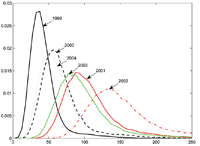Financial Mathematics �08: Contagion and Frailty in Clustering of Corporate Defaults
January 10, 2009

Distribution of future default events, estimated with Giesecke and Azizpour�s model for the years from 1999 to 2004 (x-axis, number of defaults during the year; y-axis, probability). This distribution is the key object for risk management applications. Courtesy of Kay Giesecke.
Kay Giesecke of Stanford University's CreditLab gave a plenary talk on clustering of corporate defaults at the November 2008 SIAM Conference on Financial Mathematics and Engineering. Giesecke, an assistant professor in Stanford's Department of Management Science and Engineering, was presenting recent work with his former student Shahriar Azizpour (currently a quantitative analyst at Cr�dit Suisse) on the roles of contagion and frailty in such clustering.
Traditionally, Giesecke explained, many banks and other financial institutions have used stochastic models to predict clustering of corporate defaults. Clustering in these models results from the exposure of firms to common observable factors.
But defaults, like contagious diseases, can also spread in less direct ways. When modeling the spread of a disease in a population, researchers consider both "observable" and "unobservable" individuals: The former are infected individuals with symptoms, or documented cases; the latter are either susceptible to the disease but not yet infected, or infected but without symptoms. Even though the unobservables can't be quantified as easily as the observables, there is no question that they can contribute to the spread of the disease: If a population includes large numbers of individuals from both groups, clusters of infections will erupt.
Giesecke cited recent research suggesting that models based on observable factors alone are not enough to fully explain or predict financial default clustering. Sanjiv Das, Darrell Duffie, Nikunj Kapadia, and Leandro Saita have found evidence that default clustering occurs more frequently than standard models predict, suggesting the possibility that other factors contribute to the clustering of defaults but are not captured by traditional models. In fact, in a recent study of the role of unobservable factors (collectively called frailty), Duffie, Andreas Eckner, Guillaume Horel, and Saita showed that frailty can introduce additional clustering.
Giesecke and Azizpour examined another factor: contagion, whereby the default of one firm can spread to other firms through the web of business, legal, and other contractual relationships connecting them. The collapse of a supplier, for instance, can increase the likelihood that a manufacturer will default.
In a recent example, the bankruptcy of U.S. auto parts maker Delphi in 2005 contributed to the near-bankruptcy of General Motors, the main purchaser of Delphi's products. (The inverse of this example also explains the concern among Japanese automakers about the potential failure of GM and other American car companies, with which they share parts suppliers. If GM should fail, there is a good chance that its suppliers would be forced to fold as well---directly affecting the ability of the Japanese automakers to obtain parts.) Another example is Lehman Brothers, whose collapse sent a shock wave through credit markets and put many firms that had contracts with Lehman at risk.
Both frailty and contagion generate "self-exciting" phenomena. But while frailty's effects are purely informational---essentially an implied weakness among similar firms---contagion leads to the direct propagation of financial distress through contractual links.
Using U.S. default data for the period from 1970 to 2006, Giesecke and Azizpour developed a self-exciting model of default timing to measure the roles of contagion and frailty in the clustering of corporate defaults. According to the model estimates, contagion plays a significant role, once the firms' exposure to observable and unobservable (frailty) risk factors has been controlled for. This suggests that researchers should model contagion as carefully as they do frailty: Contagion and frailty contribute roughly equally to feedback from U.S. default events. As Giesecke said in his talk, the results also indicate that "the information embedded in the past default times is more relevant for predicting future defaults" than previously believed.
These findings, Giesecke and Azizpour point out, have implications for portfolio credit risk, highlighting the need for risk estimates that take feedback from defaults into account---particularly in the ongoing credit crisis. Estimates of the amounts of risk capital needed to withstand large losses in the case of a correlated default are typically produced by traditional models, which do not incorporate default feedback. As a result, forecasts of loss distribution typically understate the probability of large losses---"particularly in times of economic stress."---Michelle Sipics

